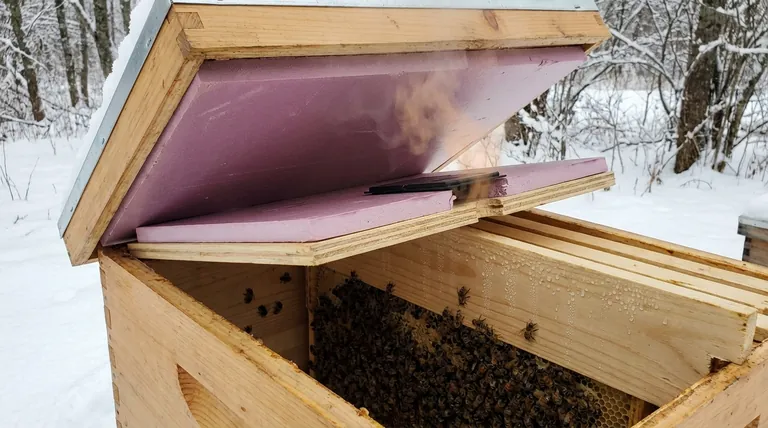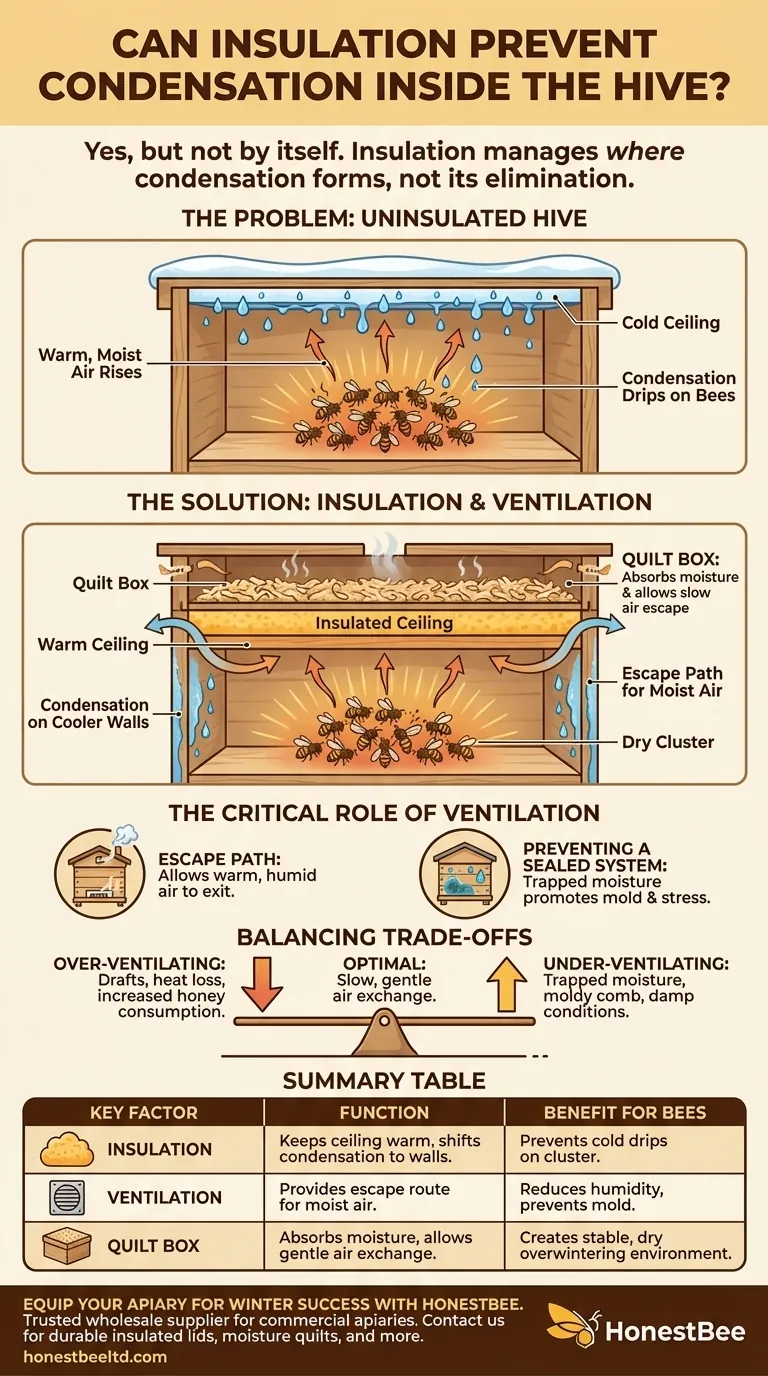Yes, but not by itself. Insulation is a critical tool for managing condensation, but it only works when combined with adequate ventilation. It does not eliminate moisture, but rather helps control where that moisture condenses, moving it away from the bees.
The core principle is not to stop condensation, but to control it. Proper insulation keeps the hive ceiling warm, which forces the moisture-laden air to either escape through ventilation or condense on the cooler hive walls, far away from the vulnerable winter cluster.

Why Condensation Forms in a Beehive
To solve the problem, we first need to understand the physics at play inside the hive during winter.
The Cluster is a Living Furnace
A winter bee cluster generates significant heat by vibrating their flight muscles. This process, along with their respiration, also releases a large amount of warm, water-saturated air.
Warm, Moist Air Rises
As basic physics dictates, this warm, humid air rises to the top of the hive cavity.
Hitting a Cold Ceiling
When this pocket of warm, moist air hits a cold surface—like an uninsulated inner cover or lid—its temperature rapidly drops. This causes the water vapor to change back into liquid water, forming condensation that drips down onto the bees.
How Insulation Changes the Equation
Insulation fundamentally alters the temperature dynamics inside the top of the hive, changing where the "cold surface" is.
Keeping the Ceiling Warm
By placing rigid foam insulation on top of the inner cover or using an insulated lid, you prevent the ceiling from becoming the coldest surface. It stays closer to the internal temperature of the hive.
Shifting the Dew Point
Because the ceiling is no longer cold, the rising moist air does not condense there. Instead, the condensation point is shifted to the next coldest surfaces: the upper hive walls.
Protecting the Cluster
Condensation running down the walls, away from the cluster, is harmless. The goal is achieved: the bees stay dry, even if the hive interior is not completely free of moisture.
The Critical Role of Ventilation
Insulation manages where condensation forms, while ventilation works to remove the moist air before it can condense at all. They are two parts of the same system.
A Path for Escape
A small upper entrance, a notched inner cover, or a dedicated quilt box provides a crucial exit path for the warm, humid air to escape the hive.
Preventing a Sealed System
Insulating a hive without providing any ventilation is a mistake. This can trap all the moisture inside, creating a damp, stagnant environment that promotes mold and stresses the colony.
The Quilt Box Solution
A popular method is the "quilt box" or "moisture quilt." This is a shallow box placed on top of the hive, filled with wood shavings. It insulates, absorbs excess moisture, and allows that moisture to slowly escape through ventilation holes, keeping the hive interior dry.
Understanding the Trade-offs
Achieving the right balance is key. Too much of a good thing can create new problems.
The Risk of Over-Ventilating
Too much ventilation can create a draft. This forces the bees to consume more of their honey stores to generate heat, defeating the purpose of insulating in the first place. The goal is a slow, gentle exchange of air.
The Risk of Under-Ventilating
Too little ventilation, especially with heavy insulation, can trap moisture. This can lead to moldy comb and stressful, damp conditions for the bees.
How to Apply This to Your Hive
Your strategy should be guided by your specific climate and goals.
- If your primary focus is retaining heat in a cold, dry climate: Use 1-2 inches of rigid foam insulation above the inner cover, but ensure there is a small upper entrance for moisture to escape.
- If your primary focus is managing moisture in a cold, damp climate: An insulated lid paired with a quilt box is an excellent system to both absorb and vent excess humidity.
- If your primary focus is overwintering a small colony: Insulation is crucial, as smaller clusters have a harder time generating sufficient heat. Pair it with a moisture quilt to keep their environment stable.
By managing the relationship between heat and moisture, you create the dry, stable winter home your bees need to thrive.
Summary Table:
| Key Factor | Function | Benefit for Bees |
|---|---|---|
| Insulation | Keeps the hive ceiling warm, shifting condensation to the walls. | Prevents cold water from dripping directly onto the winter cluster. |
| Ventilation | Provides an escape route for warm, moist air before it condenses. | Reduces overall humidity and prevents mold growth. |
| Quilt Box | Absorbs excess moisture while allowing for gentle air exchange. | Creates a stable, dry environment, ideal for overwintering. |
Equip your apiary for winter success with HONESTBEE. As a trusted wholesale supplier for commercial apiaries and distributors, we provide the durable beekeeping supplies and equipment you need to implement effective moisture management strategies. From insulated lids to moisture quilts, our products are designed to help your colonies thrive. Contact our team today to discuss your wholesale needs and ensure your bees have a dry, healthy winter. Get in touch via our Contact Form
Visual Guide

Related Products
- Black Plastic Beetle Barn Hive Beetle Trap for Beehives
- Professional Drop-Style Hive Handles for Beekeeping
- Reusable Clear Small Hive Beetle Traps for Beehives Beetle Trapping Tools
- Professional Engraved Round Hive Number Tags for Beekeeping
- HONESTBEE Entrance Bee Feeder Professional Hive Nutrition Solution for Beekeeping
People Also Ask
- What are the steps for installing hive beetle traps? A Guide to Effective Beetle Control
- Why are hive beetle traps important for beekeepers? Protect Your Hive from a Devastating Infestation
- What are the chemical-free options for trapping hive beetles? Control Pests Without Chemicals
- What tips can help prevent hive beetle infestations? Build Strong Colonies & Master Apiary Hygiene
- How do hive beetle traps work? A Beekeeper's Guide to Non-Chemical Control



















